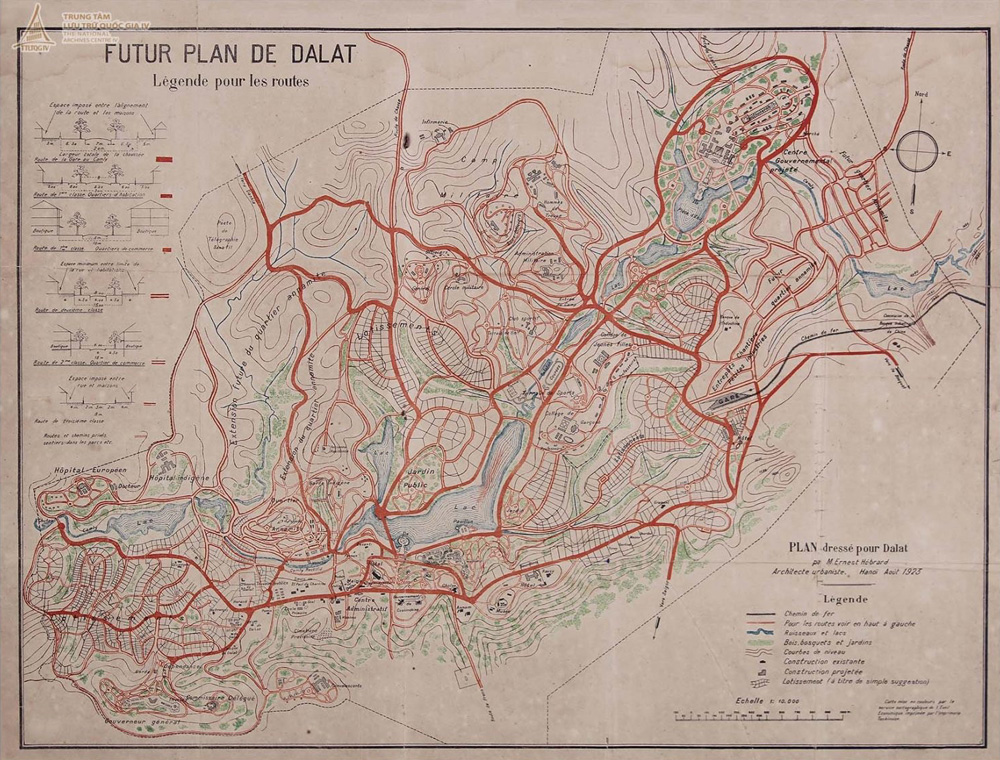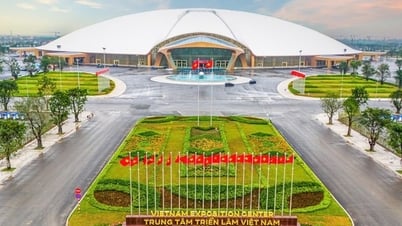Right from the first days of its "conception" (1893), Dalat received special attention from the Indochina government, which implemented many construction and development planning projects to turn Dalat into a European-style resort and the first garden city in the world .
Dalat is not only known as the city of fog, of thousands of pine trees and thousands of flowers; this place is also famous for its architectural works bearing the French mark such as: Dalat Pedagogical College, train station, Dalat market, Dalat - Pa-lat, Du-pac hotels...
Right from the early days of its "conception" (1893), Dalat received special attention from the Indochina government, which implemented many construction and development planning projects to turn Dalat into a European-style resort and the first garden city in the world.

Dalat planning map by Ernest Hébrard, 1923 (Source: National Archives Center IV).
French explorers of Dalat
According to ancient documents, Dalat was once located in an area commonly known as Lam Son - a wild and mysterious land.
Here, there are only a few scattered villages of the Highlanders. In the first half of the 19th century, during the war of aggression against Vietnam, realizing the potential of the land of Da Lat, the French government conducted the first few expeditions. However, these expeditions were only of a sketchy, survey nature.
It was not until June 21, 1893, when Dr. Yersin set foot on Lang Bian plateau. The moment of 3:30 a.m. became an important milestone, the premise for the birth of Da Lat city later.
In his expedition report, Dr. Yersin wrote: “The winding dirt roads make us believe that we are walking on the surface of a stormy sea. Lang Bian is located in the middle like an island and feels further and further away as we move forward... The coolness of the air makes me forget my fatigue.”
Attracted by the fresh climate and charm of the strange land, Dr. Yersin proposed that the Governor General of Indochina build a mountain sanatorium here where French officials and expatriates could rest without having to return to the motherland. On November 1, 1899, the Governor General of Indochina signed the Decree establishing the Upper Dong Nai province.
Right from its inception, the colonial government systematically and scientifically planned the construction and development of the city with the ambition of turning this place into a miniature tropical France. After that, many planning projects by famous architects were presented.
The first plans
In 1900, Paul Champoudry was appointed as the first Mayor of Dalat. He had solid experience in the field of urban planning after many years working at the Paris City Hall.
Paul Champoudry initiated the first urbanization project of Dalat in 1906. This project aimed at a double separation, first of all between the military and civilian poles.
Accordingly, the entire space on the right bank of the Cam Ly River is reserved for military use; the left bank is for administrative and civilian use. This means that the northern part of the plateau up to Lang Bian Mountain is the military area, the rest is for civilian use.
Residences and administrative offices were also planned to be built. However, due to lack of funds and inconsistent policies of the colonial government, this project was only partially implemented, and the appearance of the city did not change much.
On January 6, 1916, the Governor-General of Indochina issued a Decree establishing Lang Bian province and then establishing Da Lat town according to the Decree of King Duy Tan on April 20, 1916. Da Lat became a French territory within the protectorate of Central Vietnam and was placed under the direct management of the Governor-General of Indochina.
During this period, due to some special reasons when the First World War broke out, many French people decided to stay in Indochina, so they were more interested in this high-altitude resort. And after the “hibernation” period, the city rose with many constructions and mansions built.
In 1919, O'Neill proposed a new project called "The City of Dalat - Urban Perimeter Plan with Indications of Concessions" aiming at rebalancing the territory in favor of the civilian sector. O'Neill planned to build Dalat into a city of entertainment and recreation.
The world's first garden city is planned
From the 1900 development program of Governor General Paul Doumer, the first planning project in 1906 of Mayor Champourdy applying the method of functional zoning, the 1919 planning project of O'Neill; to the systematic landscape city planning project of architect Hébrard in 1923 clearly showing the mark of the Garden City.
Based on that foundation, thoughtful constructions, integrated into the natural landscape, have created a rich urban landscape of Da Lat with valuable heritages in the fields of planning and architecture.
Architect Hébrard, famous for his restoration of the Salonique in Greece (1918), began planning for Dalat at the same time as planning for the cities: Hanoi, Saigon, Cho Lon, Hai Phong and Phnom Penh.
By 1923, architect Hébrard completed the work, the project was approved by the Governor General and issued for implementation in August 1923, according to which Dalat would be a model high-altitude resort city; the city was designed according to the principles of: "Garden city planning".
For the first time, the complex problems of Da Lat city have been comprehensively studied and many solutions with meaningful orientation for the city's development have been proposed. Analyzing the project and construction program, we see:
The issue of protecting, beautifying the landscape and creating an aesthetic space for the city has received special attention from the author. The main idea throughout is to build a “City in trees and trees in the city”, with the goals focusing on protecting nature through expanding water surfaces, establishing green spaces, forest reserves and low-density construction.
On a large natural area of Lam Vien plateau, architect Hébrard arranged the city in a moderate space, about 30 thousand hectares. This is a reasonable area for a garden city with a population of 30,000 to 50,000 people (at that time, Da Lat's population was about 1,500 people).
The highlight of the project is the way to solve the problem of urban landscape. Cam Ly stream is actively embellished to become an attractive water landscape axis for the city, with a system of large and small artificial lakes with walking paths, following the slopes, connecting them seamlessly.
The main layout of the resort city and future capital, organized around this landscape axis, each lake is the nucleus of a functional subdivision.
An ardent supporter of the zoning principle, of which he was a key architect, Hébrard came to define three “cities” in one: a real Vietnamese quarter, a European city, and an administrative center. Each quarter was divided into specialized spaces.
In the project, the consistent idea that we see from Hébrard is “the city in the trees and the trees in the city”, Dalat will be an ecological city without industrial chimneys.
Although approved, the project proved too ambitious for its time, especially the road system, causing a backlash. The world economic crisis of 1929 and drastic budget cuts caused the project to fail, with only one of the three subdivisions and the lake promenade ever coming to fruition.
The following decade was a time of ambition. In 1933, Mr. Pineau proposed a new planning project that would move Dalat towards a true urban planning project, integrated with the environment. In 1943, Lagisquet continued to propose a plan to expand the urban area, proposing to improve, develop and beautify the city to build a “garden city” in the future.It can be said that from the development program of Governor General Paul Doumer in 1900, the first planning project in 1906 of Mayor Champourdy, the planning project in 1919 of O'Neill; to the systematic landscape city planning project of architect Hébrard in 1923, the mark of the Garden City was clearly defined. Based on that foundation, thoughtful constructions, integrated into the natural landscape, have created a rich urban landscape of Da Lat with valuable heritages in the fields of planning and architecture.
Source: https://danviet.vn/von-la-khu-rung-ram-sao-chinh-quyen-dong-duong-lai-quy-hoach-da-lat-la-thanh-pho-vuon-20250124140023252.htm































![[Photo] National Assembly Chairman Tran Thanh Man visits Vietnamese Heroic Mother Ta Thi Tran](https://vphoto.vietnam.vn/thumb/1200x675/vietnam/resource/IMAGE/2025/7/20/765c0bd057dd44ad83ab89fe0255b783)




































































Comment (0)